-> to the Survey Web home page | -> to English page
形態検査インターネットサーベイ結果報告書-1996A
The Internet Survey of Morphological Laboratory Tests: Report-1996A
[Every important document here is written in both Japanese and English, so please neglect queer characters other than English if you do not understand Japanese]
- このページは平成8年度文部省科学研究費補助金(奨励研究(A)課題番号08772180)の配分を受け、監修および画面編集に多くの方々のご協力を得て作成されました。
-
総評 / Overview
- 本サーベイでは、従来のスライド写真の代わりにインターネットでデジタル画像を配布するという方法をはじめて採用したが、実施期間中本ホームページへのアクセスは800回を超え、事前に何の打ち合わせもしていなかったにもかかわらず、各種病院検査部や医療従事者個人から正式な回答が電子メールで寄せられた。当初懸念した画像の品質に大きな問題はなく、今回の方法は、形態検査のサーベイ実施に必要な手間や費用を著しく削減できるうえ、配布する画像の均質性を容易に保証できる点で大きなメリットがある。今回は基本的な出題のみであっため、よりレベルの高い設問あるいはより広い分野においても実用性を確認する必要はあるが、従来よりさまざまな組織で行われてきた形態検査のサーベイにおいて、この方法の応用が検討される可能性も考えられる。[大場康寛]
- This new control survey project has been successfully conducted using the world wide web system of the internet instead of using conventional slidefilms. Over eight hundred times of access to the Survey Web were made during the operating period, official answers were received from clinical laboratories and laboratory technicians without any arrangements in advance. This method can strikingly reduce the cost and can easily equalize the quality of distributed graphic materials. Although more control surveys including complicated questions should be evaluated, this method is considered worth to be adopted by other conventional morphological surveys. [OHBA Yasuhiro]
-
尿検査 / Urinary Examination
- ほどんどの問題につき寄せられた回答はすべて正解であったが、設問番号:1996a-u51については模範回答と異なる回答があった。「小円形上皮」は明らかに誤りである。ただし、今回の設問には背景説明がないので、「組織球」という回答は合格とした。また「扁平上皮」を「偏平上皮」とした回答がみられたが、検査の信頼性にもかかわるので、正確な用語で記述するよう胆に命じて欲しい。なお、尿検査のサーベイにインターネットで配布された写真を用いるのは今回がはじめてであるが、画像が大変きれいなことに驚いている。本プロジェクトの今後の展開には大いに期待したい。[伊藤機一]
- Every answers to almost all questions agreed with the referee's identification, except that the question numbered '1996a-u51' got some different answers. 'Small round cells' is not acceptable. 'Histocyte' is acceptable because no background information of the specimen was given. Misspellings found in some answers should be considered so serious that total quality of the performance of the laboratory is not assured. In the field of the urinary examination, it was the first experience to distribute graphic materials through the internet, and the quality of graphics is surprisingly excellent. Prompt development of this project will be strongly expected. [ITOH Kiichi]
-
血液検査 / Hematology
- 初回ということで敢えて易しい問題だけを出題したため、寄せられた回答はすべて全問正解であった。画像の品質は当初予想したより高く、今回の出題のような正常像では十分であると思われたが、病的細胞の診断ではより精細な画像が要求されるので、そのような問題を出題したときにどうであるかという点につき、今後の課題としてさらに検討を望みたい。[渡辺清明]
- As this is the first survey of this project, all questions are normal blood cells and are intentionally so easy that all answers of every applicant were correct. The quality of the digitized graphics was higher than expected, and no major problem was pointed out. But identification of abnormal blood cells would be considered to require more precise graphics, so more trials are desirable for evaluation of this survey method. [WATANABE Kiyoaki]
-
微生物検査 / Microbiology
- それぞれの出題に用いた菌種名は、1996a-m11,12,13が黄色ブドウ球菌、1996a-m21,22,23が淋菌、1996a-m31,32が大腸菌、1996a-m41,42が緑膿菌、1996a-m51,52が肺炎球菌、1996a-m61,62がStreptococcus pyogenesである。初回ということで敢えて典型例だけを出題したが、細菌検査は形態だけによる判断には限界があるため、特にコロニーの性状などは迷ったかも知れない。今回の経験からサーベイ用としては十分な画質が得られることが分かったので、今後は検体採取から同定までの流れに沿った問題や、感受性検査の解釈問題など、より臨床的な内容を問う問題や、真菌の形態についての出題を加えていくとよいと思う。[菅野治重]
- Species used in each question follows: Staphylococcus aureus in 1996a-m11/12/13, Neisseria gonorrhoeae in 1996a-m21/22/23, Escherichia coli in 1996a-m31/32, Pseudomonas aeruginosa in 1996a-m41/42, Streptococcus pneumoniae in 1996a-m51/52 and Streptococcus pyogenes in 1996a-m61/62. As this is the first experience, specimens used for these questions are intentionally limited to only typical examples, and there was no problem in the quality of the digitized graphics. After this, identification of fungi, and further, questions in more clinical aspects are considered to be desirable. [KANNO Harushige]
設問と解答 / Model Answers with Corresponding Questions (->講評 / Assessments)
- 設問番号:1996a-u11 / Question Number: 1996a-u11
- これは尿沈渣のSternheimer染色像です。たくさん見える細胞は何ですか。
- This urinary sediment is Sternheimer-stained. Identify cells mainly seen here.
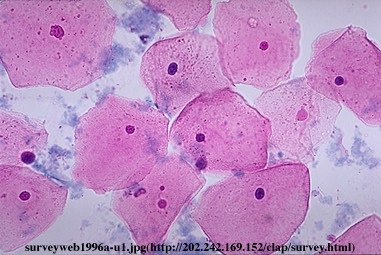
-
模範解答:扁平上皮(表層型) / Model Answer: squamous epithelium (superficial)
- 設問番号:1996a-u21 / Question Number: 1996a-u21
- これは尿沈渣のSternheimer染色像です。真ん中に見える細胞は何ですか。
- This urinary sediment is Sternheimer-stained. Identify the cells seen at the center.
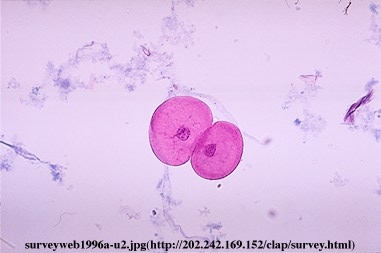
-
模範解答:扁平上皮(中層〜深層型) / Model Answer: squamous epithelium (intermediate - basal)
- 設問番号:1996a-u31 / Question Number: 1996a-u31
- これは尿沈渣のSternheimer染色像です。真ん中に見える細胞は何ですか。
- This urinary sediment is Sternheimer-stained. Identify the cell seen at the center.
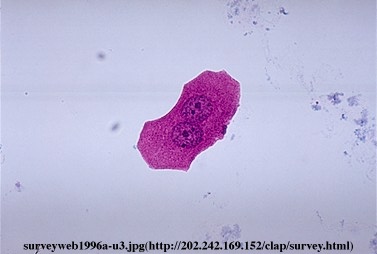
-
模範解答:移行上皮(表層) / Model Answer: transitional epithelium (superficial)
- 設問番号:1996a-u41 / Question Number: 1996a-u41
- これは無染色の尿沈渣です。向かって左側に見える細胞は何ですか。
- This is urinary sediment with no staining. Identify the cell seen at the left.
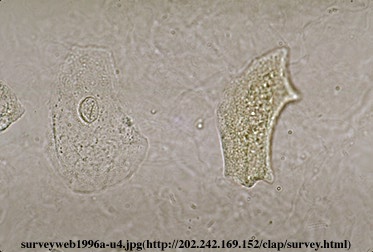
-
模範解答:扁平上皮 / Model Answer: squamous epithelium
- 設問番号:1996a-u42 / Question Number: 1996a-u42
- これは無染色の尿沈渣です。向かって右側に見える細胞は何ですか。
- This is urinary sediment with no staining. Identify the cell seen at the right.

-
模範解答:移行上皮 / Model Answer: transitional epithelium
- 設問番号:1996a-u51 / Question Number: 1996a-u51
- これは尿沈渣のSternheimer染色像です。真ん中に見える細胞は何ですか。
- This urinary sediment is Sternheimer-stained. Identify the cells seen at the center.
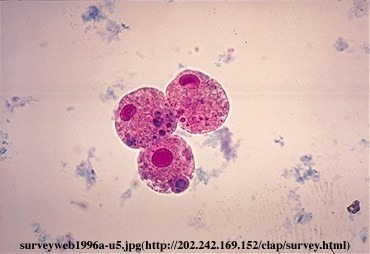
-
模範解答:細胞質内封入体細胞 / Model Answer: inclusion-bearing cell (intracytoplasmic inclusion)
- 設問番号:1996a-h11 / Question Number: 1996a-h11
- これは末梢血液のライト・ギムザ染色像です(×1,000)。この有核細胞は何ですか。
- This is a microphotograph of peripheral blood smear stained with Wright-Giemza's stain (x 1,000). Identify a nucleated cell in this smear.
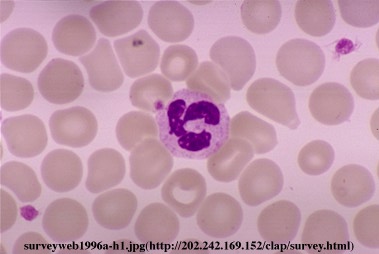
-
模範解答:好中球(分葉核球) / Model Answer: neutrophil (segmented form)
- 設問番号:1996a-h21 / Question Number: 1996a-h21
- これは末梢血液のライト・ギムザ染色像です(×1000)。この有核細胞は何ですか。
- This is a microphotograph of peripheral blood smear stained with Wright-Giemza's stain (x 1,000). Identify a nucleated cell in this smear.
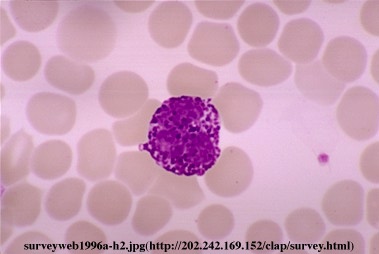
-
模範解答:好塩基球 / Model Answer: basophil
- 設問番号:1996a-h31 / Question Number: 1996a-h31
- これは末梢血液のライト・ギムザ染色像です(×1000)。この有核細胞は何ですか。
- This is a microphotograph of peripheral blood smear stained with Wright-Giemza's stain (x 1,000). Identify a nucleated cell in this smear.
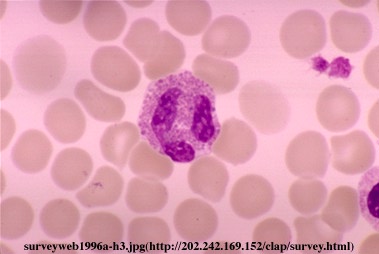
-
模範解答:好酸球 / Model Answer: eosinophil
- 設問番号:1996a-h41 / Question Number: 1996a-h41
- これは末梢血液のライト・ギムザ染色像です(×1000)。この有核細胞は何ですか。
- This is a microphotograph of peripheral blood smear stained with Wright-Giemza's stain (x 1,000). Identify a nucleated cell in this smear.
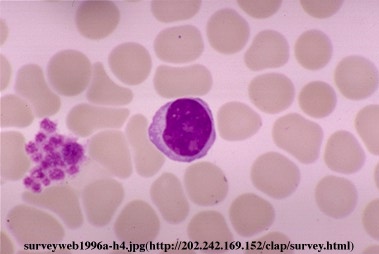
-
模範解答:リンパ球 / Model Answer: lymphocyte
- 設問番号:1996a-h51 / Question Number: 1996a-h51
- これは末梢血液のライト・ギムザ染色像です(×1000)。この有核細胞は何ですか。
- This is a microphotograph of peripheral blood smear stained with Wright-Giemza's stain (x 1,000). Identify a nucleated cell in this smear.
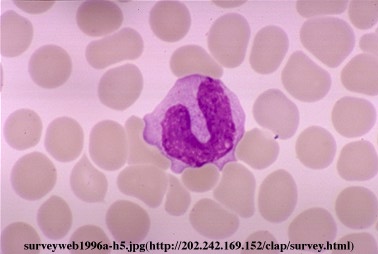
-
模範解答:単球 / Model Answer: monocyte
- 設問番号:1996a-m11 / Question Number: 1996a-m11
- これは膿のグラム染色像です。ここに見える細菌はグラム陽性球菌、同杆菌、グラム陰性球菌、同杆菌のどれですか。
- This pus smear is Gram-stained. Identify whether these bacteria seen here are Gram-positive or negative, and cocci or rods.
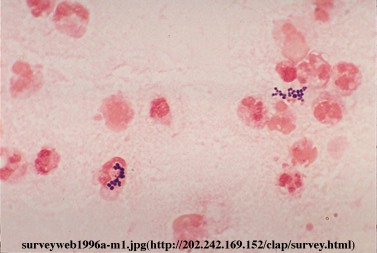
-
模範解答:グラム陽性球菌 / Model Answer: Gram-positive cocci
- 設問番号:1996a-m12 / Question Number: 1996a-m12
- これは膿のグラム染色像です。ここに見える細菌は起炎菌でしょうか、否でしょうか。
- This pus smear is Gram-stained. Decide whether these bacteria seen here are pathogenic or not.

-
模範解答:起炎菌 / Model Answer: pathogenic
- 設問番号:1996a-m13 / Question Number: 1996a-m13
- これは膿のグラム染色像です。ここに見える細菌の最も疑われる種名は何ですか。
- This pus smear is Gram-stained. What species is the most probable for the bacteria seen here?

-
模範解答:黄色ブドウ球菌(Staphylococcus aureus) / Model Answer: Staphylococcus aureus
- 設問番号:1996a-m21 / Question Number: 1996a-m21
- これは尿道分泌物のグラム染色像です。真ん中付近に見える細菌はグラム陽性球菌、同球菌、グラム陰性球菌、同杆菌のどれですか。
- This smear of a urethra discharge is Gram-stained. Identify whether these bacteria seen at the center are Gram-positive or negative, and cocci or rods.
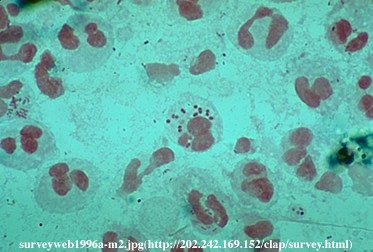
-
模範解答:グラム陰性球菌 / Model Answer: Gram-negative cocci
- 設問番号:1996a-m22 / Question Number: 1996a-m22
- これは尿道分泌物のグラム染色像です。真ん中付近に見える細菌は起炎菌でしょうか、否でしょうか。
- This smear of a urethra discharge is Gram-stained. Decide whether these bacteria seen at the center are pathogenic or not.

-
模範解答:起炎菌 / Model Answer: pathogenic
- 設問番号:1996a-m23 / Question Number: 1996a-m23
- これは尿道分泌物のグラム染色像です。真ん中付近に見える細菌の最も疑われる種名は何ですか。
- This smear of a urethra discharge is Gram-stained. What species is the most probable for the bacteria seen at the center?

-
模範解答:淋菌(Neisseria gonorrhoeae) / Model Answer: Neisseria gonorrhoeae
- 設問番号:1996a-m31 / Question Number: 1996a-m31
- これはある細菌のドリガルスキー改良培地上のコロニーです。この細菌に見られる生化学的性状の特徴は何ですか。
- These bacterial colonies are formed on the BTB Lactose Agar. Identify the metabolic characteristics of these bacteria.
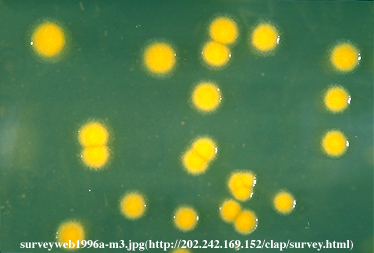
-
模範解答:乳糖分解(+) / Model Answer: Lactose(+)
- 設問番号:1996a-m32 / Question Number: 1996a-m32
- これはある細菌のドリガルスキー改良培地上のコロニーです。このコロニーの形態的特徴は何ですか。
- These bacterial colonies are formed on the BTB Lactose Agar. Identify the morphological characteristics of these colonies.

-
模範解答:円形、均質、不透明、光沢あり、湿潤 / Model Answer: round, homogeneous, opaque, polished, wet
- 設問番号:1996a-m41 / Question Number: 1996a-m41
- これはある細菌のドリガルスキー改良培地上のコロニーです。この細菌に見られる生化学的性状の特徴は何ですか。
- These bacterial colonies are formed on the BTB Lactose Agar. Identify the metabolic characteristics of these bacteria.
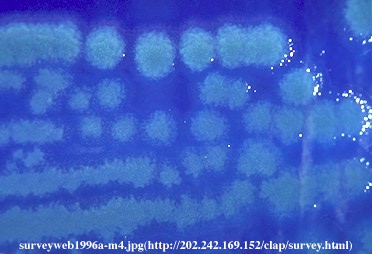
-
模範解答:乳糖分解(−) / Model Answer: Lactose(-)
- 設問番号:1996a-m42 / Question Number: 1996a-m42
- これはある細菌のドリガルスキー改良培地上のコロニーです。このコロニーの形態的特徴は何ですか。
- These bacterial colonies are formed on the BTB Lactose Agar. Identify the morphological characteristics of these colonies.

-
模範解答:やや不整な円形、やや不均質、不透明、光沢あり、湿潤 / Model Answer: slightly distorted round, slightly heterogeneous, opaque, polished, wet
- 設問番号:1996a-m51 / Question Number: 1996a-m51
- これはある細菌の血液寒天培地上のコロニーです。この細菌に見られる溶血性はα、βまたはγ性のどれですか。
- These bacterial colonies are formed on the blood Agar. Identify whether the hemolytic characteristics of these bacteria is alpha, beta or gamma.
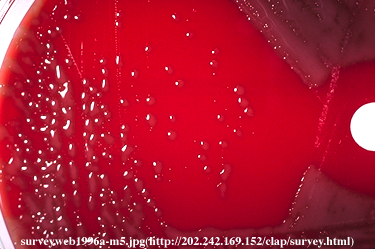
-
模範解答:α / Model Answer: alpha
- 設問番号:1996a-m52 / Question Number: 1996a-m52
- これはある細菌の血液寒天培地上でのオプトヒンテストの結果です。この細菌の最も疑われる種名は何ですか。
- These bacterial colonies are formed on the blood Agar with the optochin test applied. What species is the most probable for these bacteria?

-
模範解答:肺炎球菌(Streptococcus pneumoniae) / Model Answer: Streptococcus pneumoniae
- 設問番号:1996a-b61 / Question Number: 1996a-b61
- これはある細菌の血液寒天培地上のコロニーです。この細菌に見られる溶血性はα、βまたはγ性のどれですか。
- These bacterial colonies are formed on the blood Agar. Identify whether the hemolytic characteristics of these bacteria is alpha, beta or gamma.
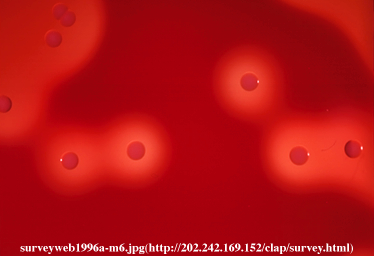
-
模範解答:β / Model Answer: beta
- 設問番号:1996a-b62 / Question Number: 1996a-b62
- これはある細菌の血液寒天培地上のコロニーです。この細菌の最も疑われる屬名は何ですか。
- These bacterial colonies are formed on the blood Agar. What genus is the most probable for the bacteria seen here?

-
模範解答:連鎖球菌(Streptococcus) / Model Answer: Streptococcus)
監修 / Supervisors
- 近畿大学ライフサイエンス研究所教授(前医学部臨床病理学教授) 大場康寛 / Professor OHBA Yasuhiro, Kinki Univ., Japan
- 神奈川県立衛生短期大学衛生技術科教授 伊藤機一(尿検査) / Professor ITOH Kiichi, Kanagawa Prefectural College of Medical Technology, Japan (urinary examination)
- 慶応義塾大学医学部中央臨床検査部教授 渡辺清明(血液検査) / Professor WATANABE Kiyoaki, Keio Univ., Japan (hematology)
- 千葉大学医学部臨床検査医学講師 菅野治重(微生物検査) / Lecturer KANNO Harushige, Chiba Univ., Japan (microbiology)
なお、サーベイの内容についてこれらの方々に直接お問い合わせになることはご遠慮ください。ご質問あるいはご意見はすべて受付までお寄せください。
These supervisors cannot respond to any direct inquiry. If you have any questions or suggestions, please feel free for contacting the administrator.
画面編集
- ページ編集:萩原三千男(東京医科歯科大学医学部附属病院検査部)
- 編集協力:野崎 司(東海大学医学部附属病院中央臨床検査センター)
- 技術協力:角田達雄(ヒューマンウエア)
-> to the Survey Web home page | -> to English page
























